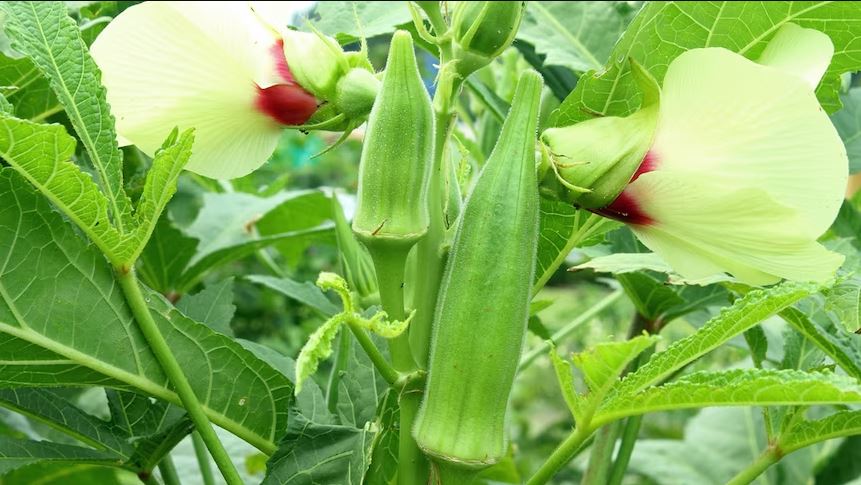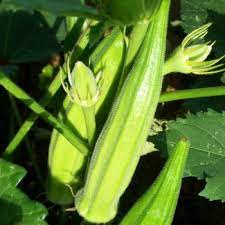
It is recommended to sow seeds in a warm indoor environment from late winter to early spring, or alternatively, purchase plants during late spring if available. Optimal growth conditions for okra entail a warm and humid environment or a mild, sunny, and sheltered outdoor location with fertile soil. Regular feeding and watering are essential for successful cultivation, with harvesting typically taking place from late summer through autumn. At the end of the season, it is advisable to compost okra plants.
How to grow Okra in your garden
Seeding
Okra is a warm-weather plant that loves full sun, so choose the sunniest plot in your garden.
- In colder regions, start your seeds indoors 6 to 8 weeks before planting. The earliest you should plant them outside is 2 weeks after your local frost date.
- Seeds should be started in peat pots since okra does not transplant well. They have fragile taproots that you need to be gentle with. We suggest you to water your seedlings an hour before doing the transplant.
- In warmer regions, you can direct-sow seeds into the garden, and the time of planting is not so important.
- Okra seeds are fragile and should be handled with great care.
- Seeds should be sown 4 to 6 inches apart. Rows should be set 3 feet apart.
- Seed depth should be 1 inch.
- Once your seedlings reach a height of 6 inches, thin them to 1.5 to 2 feet apart.
- The soil ph is not too important since okra can grow in soils that are slightly acidic or slightly alkaline.
- Plants reach maturity in 50 to 60 days, depending on the variety.
Watering and Fertilizing
Okra is able to withstand dry conditions better than most vegetables, but keeping it watered during the production of the pods will increase output.
- For best results, okra requires an inch of water per week.
- Avoid using a high-nitrogen fertilizer, since the plants will overgrow their vegetation and neglect the pods.
- Okra will thrive in most soil types, as long as they’re well-draining and do not get waterlogged.
Harvesting
Don’t let your pods grow too long! Harvest okra when they’ve grown 2-4 inches long.
- Your plants may start to flower and produce pods as they reach a height of 2 feet. Some varieties can grow up to 14 feet tall!
- It’s best to harvest in the morning before the afternoon heat.
- You can test the pods by bending the tip. If it bends easily without breaking then your pod is ripe for picking.
- Only immature okra pods are suitable for cooking. Once they pass 4 inches in length and harden up, they’re no longer edible. One option is to allow the overgrown pods to finish growing on the plant and save them as seed pods for next year, but this will exhaust the plant and will limit the production of other pods. The other option is to simply cut it off and dispose of it.
- Slice the pods off using a sharp knife rather than breaking them off.
- Varieties that aren’t spineless have small spines on the pods, but these disappear during boiling. If you’re growing a non-spineless variety then use gloves and wear long sleeves, since spines can cause severe itching and rashes.
Storage
Okra does not last long after picking. Store unwashed okra pods in the fridge for up to 3 days. Washed pods will turn slimy because of the moisture.
Pods can be preserved by blanching and freezing, by dehydration, pickling, and canning. They can also be combined with tomatoes to increase the acid content for canning.
Varieties
Different varieties of okra are available based on the presence of spines, pod color, and size of the plant.

- Annie Oakley II: spineless, dark green pods, compact plant
- Jambalaya: early-maturing, green pods
- Burgundy: dark red pods instead of green
- Cajun Delight: spineless, dark green pods
- Clemson Spineless: spineless (obviously), dark green pods
If you use an early-maturing variety and live in a warmer southern climate with a long growing season, you can easily get more than one harvest per year.
Dwarf varieties also exist for gardeners with limited space.
Pests
Okra is less prone to pest infestations than most vegetables but they can still happen. Be on the lookout for aphids and stink bugs near young pods. Cabbage worms and flea beetles may be found eating a plant’s leaves. Check the undersides of leaves for eggs, since many pest insects reproduce this way.
Fusarium wilt is a fungus affecting several vegetables including okra. Plants will begin to wilt during the day and recover during the night. More and more of the plant gradually turns yellow until the entire plant wilts and dies. The best thing to do is remove the plant along with as much root as possible and burn it or bury it in an area that won’t be used for gardening. Then, clean your gardening tools to prevent the spread of disease any further.
Frequently Asked Questions
The hot sun of Texas is a great place for growing okra!
- Some of the best varieties for Texas are Annie Oakley, Long Pod Dwarf, Cajun Delight, Clemson Spineless, Emerald, Burgundy, and Green Best.
- Plant your seeds anytime between late April and early June, 2 weeks after your last local frost date.
- Okra will survive with minimal watering, but you’ll get a better harvest if you water it every 7 to 10 days. Depending on how sandy your soil is, you may have to water it more often than that.
- If temperatures rise above 35 degrees C, make sure your plants are getting extra water, since this much heat can stunt the growth of the pods.
How do I grow okra in Florida?
Florida has the warm weather that okra loves!
- The best varieties for Floridians are Clemson Spineless, Annie Oakley II, Cajun Delight, and Emerald.
- In southern Florida, you can grow multiple crops in a year by planting in the spring and the fall seasons, since the climate in the southern region is so warm.
- Pests like aphids, cucumber beetles, stink bugs, and caterpillars are more prevalent in warmer states like Florida so it’s a good idea to check for them once a week or so.
- If growing okras in an urban area, you can easily grow them in a 5-gallon pail with drainage holes in the bottom. This will allow you to place the plant in a sunny area and bring it into shelter in the case of strong winds. Keep in mind that you’ll have to be more diligent about watering it since it can’t extract water from the ground.
Can I grow okra in a pot?
Yes! You can plant okra in a pot that is at least 3 gallons in size. Growing okra in pots is a great way to have a plant or two on your balcony or deck. You can also optimize the location of your plant for sunlight. Just make sure you drill holes in the bottom of the pot and use a well-draining soilless potting mix. When growing anything in a pot, you must be more diligent about watering it since it can’t extract water from the ground.
How tall does okra grow?
Depending on which okra variety you choose, it can grow from 4 to up to 8 feet tall! Dwarf varieties also exist which don’t grow higher than 5 feet, ideal for growing on a patio.
Large varieties:
- Hill Country Red: 6 feet tall
- Silver Queen: 6 feet tall
- Go Big: up to 7 feet tall
- Emerald: up to 8 feet tall
- Cow Horn: up to 14 feet tall
Dwarf Varieties:
- Baby Bubba: 3 to 4 feet tall
- Blondy: up to 4 feet tall
- Cajun Delight: 4 feet tall
- Annie Oakley II: 4.5 feet tall
- Burgundy: 4 feet tall
- Clemson Spineless: 4 to 5 feet tall
Can okra and corn grow together?
They certainly can, but make sure they aren’t shading each other since okra plants need their sun in order to stay healthy. Okra can be companion-planted with most garden vegetables, including corn. It’s also worth mentioning that in the three-sisters method (corn, beans, and squash), okra can stand in for corn to provide shade to the squash.
Can you grow okra in a 5-gallon bucket?
It’s a common question, how does okra grow in a pail? The answer is that it grows very well! 5-gallon pails are an ideal size for okra roots and are very easy to come by. The rules for how to grow okra in a container are simple – use a soilless potting mix and make sure you have at least one drainage hole in the bottom. Waterlogged soil will result in root rot. The bucket handle makes it easy to pick up and move your plant around in case of a storm coming.
